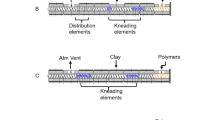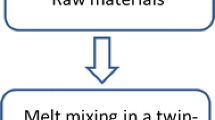Abstract
Melt processing is challenging for recycling of mineral-filled polypropylene (PP) composites because the melt flow system, the viscoelasticity and the appearance of the extrudate profile change due to a combination of extensive shear forces and thermal-oxidative degradation. The flow pattern and the swelling behaviour of polypropylene-co-ethylene-kaolin (PP-co-E-kaolin) composite with 20% (by wt) kaolin and 5% (by wt) maleic anhydride-graft-polypropylene (PP-g-Ma) were distinguished using a single-screw extruder operated at different die temperatures and extrusion cycles. The compound was prepared by mixing the ingredients using a heated two-roll mill, whereas the composite rheological and die swell measurements were obtained from the single-screw extruder. Confirmation of the obtained flow behaviour was evaluated using an Ubbelhode viscometer and a melt flow index (MFI) tester. The apparent viscosity (ηapp) of molten composites and the swelling ratio (B) of extrudates decreased with increasing the extrusion temperature, reflecting the PP melt strength weakened with increasing the amount of viscous component. At the same time, increasing MFI values also indicate the production of lower molecular weight PP-co-E composites. This was caused by the backbone chain-scission reaction due to the thermal-oxidative degradation in the PP-co-E matrix. Meanwhile, in the case of multiple extrusion cycles, a gradual increase in the composite molar mass (Mv) and B justified the development of chemical crosslinking in the PP-co-E-kaolin composite extrudates.








Similar content being viewed by others
References
Didem CU, Ferrer L, Puig R, Pere FIP (2018) A functional fillers improving environmental behavior of plastic. a review on LCS studies. Sci Total Environ 626:927–940
Singh N, Hui D, Singh R, Ahuja IPS, Feo L, Fraternali F (2017) Recycling of plastic solid waste: a state of art review and future applications. Compos B 115:409–422
Keskisaari A, Karki T, Vuorinen R (2019) Mechanical properties of recycled polymer composites made from side-stream materials from different industries. Sustainability 11:6054
Salavati M, Yousefi AA (2019) Polypropylene-clay micro/nanocomposites as fused deposition modeling filament: effect of polypropylene-g-maleic anhydride and organo-nanoclay as chemical and physical compatibilizers. Iran Polym J 28:611–620
Rahim NAA, Ariff ZM, Ariffin A, Jikan SS (2011) Study on effect of filler loading on the flow and swelling behavior of polypropylene-kaolin composites using single screw extruder. J Appl Polym Sci 119:73–83
Saw LT, Rahim NAA, Uy-Lan DN (2014) Rheological and thermal behavior of polypropylene kaolin composites. Malaysian J Anal Sci 18:360–367
Grala M, Bartczak Z, Rozanski A (2016) Morphology, thermal and mechanical properties of polypropylene/SiO2 nanocomposites obtained by reactive blending. J Polym Res 23:25
Vardai R, Lummerstoper T, Pretschuh C, Jerabek M, Gahlettner M, PukanszkyB RK (2019) Impact modification of PP/wood composites: a new approach using hybrid fibers. Express Polym Lett 13:223–234
Wang K, Tang C, Zhao C, Yang H, Zhang Q, Du R, Fu Q (2007) Rheological investigations in understanding shear-enhanced crystallization of isotactic poly(propylene)/multi-walled carbon nanotube composites. Macromol Rapid Comm 28:1257–1264
Khumalo VM, Karger-Kocsis J, Thomann R (2010) Polyethylene/synthetic boehmite alumina nanocomposites: structure, thermal and rheological properties. Express Polym Lett 4:264–274
Delva L, Ragaert K, Degrieck J, Cardon L (2014) The effect of multiple extrusions on the properties of montmorillonite filled polypropylene. Polymers 6:2912–2927
Jikan SS, Samsudin MSF, Ariff ZM, Ishak ZAM, Ariffin A (2008) Relationship of rheological study with morphological characteristics of multicomponent (talc and calcium carbonate) filled polypropylene hybrid composites. J Reinf Plast Compos 28:2577–2787
KongM HuangY, LvY YQ, Li G, Larson RG (2018) Elongation thinning and morphology deformation of nanoparticle-filled polypropylene/polystyrene blends in elongational flow. J Rheol 6:11–20
Rodrigues JF, Bezerra CC (1996) A viscometric method for the determination of induction period for polymer thermal oxidation. Polym Bull 36:347–353
Saw LT, Uy-Lan DN, Rahim NAA, Kahar AWM, Viet CX (2015) Processing degradation of polypropylene-ethylene copolymer-kaolin composites by a twin-screw extruder. Polym Degrad Stabil 111:32–37
Saw LT, Zainuddin F, Cao XV, UyLan DN (2020) The thermal-mechanical degradation of mineral-filled polypropylene-ethylene copolymer composites during extrusion process. Polym Compos 42:83–97
Sombatsompop N, Thongsang S (2001) Rheology, morphology, and mechanical and thermal properties of recycled PVC pipes. J Appl Polym Sci 82:2478–2486
Azizi H, Ghasemi I, Karrabi M (2008) Controlled-peroxide degradation of polypropylene: rheological properties and prediction of MWD from rheological data. Polym Test 27:548–554
Costa HMD, Ramos VD, Oliveira MG (2007) Degradation of polypropylene (PP) during multiple extrusions: thermal analysis, mechanical properties and analysis of variance. Polym Test 26:676–684
Tochacek J, Jancar J, Kalfus J, Hermanova S (2011) Processing stability of polypropylene impact-copolymer during multiple extrusion:effect of polymerization technology. Polym Degrad Stabil 96:491–498
Zhou Y, Wang J, Cai SY, Wang ZG, Zhang NW, Ren J (2018) Effect of POE-g-GMA on mechanical, rheological and thermal properties of poly(lactic acid)/poly(propylene carbonate) blends. Polym Bull 75:5437–5454
Kopf AH, Koorengevel MC, Walree CAV, Dafforn RTR, Antoinette Killian J (2019) A simple and convenient method for the hydrolysis of styrene-maleic anhydride copolymers to styrene-maleic acid copolymers. Chem Phys Lipids 218:85–90
Gryn’ova G, Hodgson JL, Coote ML (2011) Revising the mechanism of polymer autooxidation. Org Biomol Chem 9:480–490
Acknowledgements
The author would like to acknowledge the support from the Fundamental Research Grant Scheme (FRGS) under a grant number of FRGS: 9003-00328 from the Ministry of Education Malaysia.
Author information
Authors and Affiliations
Corresponding author
Supplementary Information
Below is the link to the electronic supplementary material.
Rights and permissions
About this article
Cite this article
Abdul Rahim, N., Ariff, Z.M., Abd Jalil, . et al. Flow characteristics of degraded polypropylene-co-ethylene kaolin composite extruded at different temperatures and extrusion cycles using single-screw extruder. Iran Polym J 30, 1201–1210 (2021). https://doi.org/10.1007/s13726-021-00969-y
Received:
Accepted:
Published:
Issue Date:
DOI: https://doi.org/10.1007/s13726-021-00969-y




